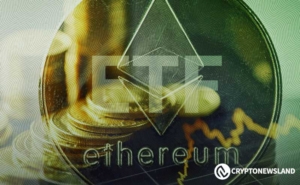Policy benefits and confusing behaviors coexist. Is Trump a true crypto builder or a bigger scythe?
The cryptocurrency sector, due to its emerging nature, high risks and high returns, as well as the lack of完善 regulation, has become one of the most sensitive areas in the tariff storm.
Author: Penny, Rhythm BlockBeats
Since Trump and his wife launched their own meme coins $Trump and $MELANIA, attracting massive funding participation, the cryptocurrency market has quickly fallen into a state of liquidity exhaustion. On the other hand, the impact of the domestic AI large model DeepSeek, sovereign nations canceling the fiat status of Bitcoin, and a series of negative news such as increased tariffs in the U.S. have further exacerbated the already sluggish market.
The first major drop after the New Year was triggered by Trump's tariff increases.
Policy Binding Coin Prices? Highly Sensitive Crypto Market
Trump's tariff policy is hitting the market hard. On February 1, local time, U.S. President Trump signed a tariff order imposing an additional 25% tariff on imports from Canada and Mexico, and a 10% tariff on energy resources from Canada, set to take effect on the 4th. Additionally, Trump signed an executive order on the 1st to impose an additional 10% tariff on goods imported from mainland China.
The global risk market reacted swiftly, with cryptocurrencies being the first to bear the brunt. On that day, the price of Bitcoin plummeted from around $105,000, breaching the $100,000 mark, and even briefly falling below $92,000, with a drop of over 7% within 24 hours. Ethereum also dropped about 25%, reaching its lowest level since early September last year, while other mainstream cryptocurrencies also saw significant declines, all dropping over 10%, marking an epic crash.

On February 3, Trump announced that he had reached an agreement with the President of Mexico to immediately suspend the anticipated tariffs for one month. Following the delay in tariff policy, Bitcoin rebounded to a high of $102,500, Ethereum rebounded to a high of $2,923, and other mainstream coins generally returned to their prices before the crash.
Jeff Park, Chief Strategy Officer at Bitwise Alpha, stated that tariffs may only be a temporary tool, but in the long run, Bitcoin will not only rise but will do so faster, as both sides in a trade imbalance want Bitcoin, leading to the same outcome: higher prices and faster growth.
It can be said that the tariff increases caused a significant drop in global stock markets, and coupled with other negative news, the cryptocurrency market also experienced a downturn. The tariff increases not only reshaped the international trade landscape but also dealt a heavy blow to global financial market confidence. The cryptocurrency sector, due to its emerging, high-risk, high-reward nature and incomplete regulation, has become one of the most sensitive areas in this storm, further confirming the increasingly close relationship between the cryptocurrency market and global macroeconomic policies.
Issuing Meme Coins to Drain the Market
On January 18, 2025, Trump announced the launch of his personal meme coin $TRUMP on his social media account. Once launched, the coin surged over 15,000% within just 12 hours, reaching around $30, with a market cap exceeding $80 billion. Such astonishing growth and massive market cap quickly attracted a flood of funds, leading many investors who originally invested in mainstream cryptocurrencies like Bitcoin and Ethereum to sell off their holdings in favor of going all-in on $TRUMP. Other coins, except for SOL, were heavily drained in the short term, while other meme coins and AI Agent tokens saw significant declines.
Moreover, the issuing team of Trump Coin holds as much as 80% of the locked coins, meaning they have strong control over the coin's price. As the lock-up period gradually unlocks in the future, whether through direct dumping on exchanges or staking on DeFi chains, it could have a huge impact on the market. At the same time, such behavior would further disrupt the market order in the cryptocurrency sector, making it harder for other genuinely valuable cryptocurrency projects to secure funding, resulting in an imbalance in the entire cryptocurrency ecosystem.
The draining effect brought by Trump's coin issuance not only led to unreasonable short-term capital flows in the cryptocurrency sector but also had a severe negative impact on the development of other cryptocurrency projects and market stability, pressing the pause button on the originally booming DeSci, DeFAI, and AI Agent sectors. According to the cryptocurrency sector's fast-paced tradition of favoring new over old, these sectors will need greater momentum to regain their former glory, leaving the cryptocurrency market facing more uncertainty and risk.
Arthur Hayes, co-founder and Chief Information Officer of BitMEX, believes that the near $100 billion fully diluted valuation (FDV) of $TRUMP within 24 hours is an absurd market signal. The surge of $TRUMP is reminiscent of the FTX purchasing advertising space for MLB umpires during the 2021 bull market—symbolizing the nearing market top.
Liquidation and Promotion: The Confusing Behavior of WLFI
Arkham data shows that World Liberty Financial conducted a large-scale transfer of crypto assets on the evening of February 3, with ETH holdings dropping from around 66k on February 2 to just 52, almost completely liquidating its ETH assets, primarily flowing into a Coinbase Prime deposit address.

At this sensitive time of asset transfer, Trump's son Eric Trump stated on his social media platform that now is the best time to increase ETH holdings (In my opinion, it's a great time to add ETH.). The initial version of the tweet even included the line "You can thank me later."

The community expressed skepticism, with attentive investors noting that the ETH holdings dropping from 66k to 66 is a clear attempt to avoid detection of asset transfer, leading to suspicions of a conspiracy to profit from retail investors. WLFI explained that these actions are aimed at maintaining a strong, secure, and efficient financial system, merely reallocating assets for ordinary business purposes, and will not sell tokens. However, once the funds are transferred to Coinbase Prime, we cannot know their exact use, and investors can only analyze based on price fluctuations and subsequent asset operations by WLFI.
Interestingly, on the morning of February 6, Eric publicly promoted BTC while also mentioning the family project WLFI, leading the community to jokingly ask, "Is it time to sell Bitcoin next?" Perhaps this was indeed a promotion before offloading, perhaps to boost confidence suppressed by the tariff increases, or perhaps just routine promotion of the family project, as promoting and CX (customer experience) is the norm for these individuals.

Crypto Tsar, But Also a Major Harvest?
David Sacks, chairman of the Crypto Council, is well-known as one of the founders of PayPal and later gained fame by creating Yammer and selling it to Microsoft for $1.2 billion. In the cryptocurrency sector, David Sacks is most notably an investor in the crypto venture capital firm Multicoin and a major proponent of Solana, often referred to as the "Crypto Tsar."
Since $TRUMP is deployed on the Solana chain, and David Sacks remained silent about these "zero-sum meme coins" when Trump launched the $TRUMP coin, many believe that the chairman of the Crypto Council is somehow involved.

Another piece of evidence is that David Sacks has a "criminal record." In March 2024, David Sacks posted about his own memecoin $Sacks.
Although he tweeted nine times telling people not to buy it when they started purchasing, this has already confirmed evidence that he "once issued a coin," which is exactly the same method as issuing the $TRUMP coin. (According to community members, David Sacks recently deleted his posts about $Sacks.)

This has led many to develop a distaste for David Sacks, feeling that his methods are too opportunistic and overly eager to profit through such radical means. Even if Sacks did not directly participate, as the chairman of the Crypto Council, he should be held accountable for this incident. There are even rumors suggesting that someone proposed replacing the entire leadership team of David Sacks's Crypto Council with a new one.
On February 5, David Sacks reiterated his goals during a press conference held at 3:30 AM Beijing time, stating that he would "clarify the crypto regulatory framework," "ensure that crypto innovation occurs domestically in the U.S.," and "create a golden age for digital assets," but did not announce any new (or specific) content. When mentioning the establishment of a Bitcoin reserve, David Sacks used the term "evaluate," which is a relatively mild term (previously, the U.S. government would use "evaluate" to dodge the issue when it had to address it but did not want to truly resolve it). Perhaps due to the press conference "not releasing any positive news," leading to unmet market expectations, Bitcoin fell back below $99,000, hitting a low of $96,147.
Is He a True Builder, or Just a Bigger Scythe?
Looking back at Trump's actions over the years, his attitude towards cryptocurrency has undergone a significant shift. During his previous term, he publicly stated that cryptocurrencies like Bitcoin were "scams," but now he promises to make the U.S. the global "crypto capital" and a "Bitcoin superpower," even forming a cryptocurrency task force, establishing a family DeFi project, lifting restrictions on new token sales, and strengthening ties between cryptocurrency companies and traditional financial enterprises.
There may be multiple reasons behind Trump's change in attitude. On one hand, the cryptocurrency market has developed rapidly in recent years, boasting a large investor base and significant economic influence, attracting this power could help increase his political support; on the other hand, there are powerful interest groups behind the cryptocurrency industry, which may exert influence on Trump through political donations, prompting him to implement policies favorable to cryptocurrency development. Additionally, Bitcoin can be seen as a tool to hedge against the weakening status of the dollar, and incorporating it into national strategic reserves is also a means to attract capital inflows and maintain dollar hegemony.
As the election results unfold, Trump's every move gradually becomes a barometer for the cryptocurrency sector. Especially with Trump launching his own meme coin before taking office, it has sparked a frenzy among countless investors both inside and outside the circle, creating many phenomenal wealth myths. Initially thought to be the start of a bull market, the subsequent issuance of the $MELANIA token shattered this illusion, causing the market to cool down and question the purpose of his coin issuance. The previously booming AI Agent sector has been heavily drained by $TRUMP and $MELANIA, and coupled with the impact of DeepSeek, it has remained sluggish. Although the frenzy for memes continues, the peak market caps of numerous tokens are shrinking, the time to zero is shortening, and mainstream coins continue to decline after the celebration, leading us to ponder whether Trump's pro-crypto stance is genuinely aimed at being a builder or merely maximizing profits for his interest groups and U.S. hegemony during his term, ultimately leaving a trail of devastation.
In the short term, the market will inevitably experience volatility to digest various major trends, but long-term value growth and industry consolidation require more than just favorable policies; it necessitates a two-way game between the market and politicians. From his series of commitments and statements, he seems to hold a positive supportive attitude towards cryptocurrency. However, his past remarks and the drastic shift in stance make it hard to fully trust. Will he truly spare no effort in promoting the development of cryptocurrency and make the U.S. a paradise for crypto? Known for his "unexpected" nature, will the favorable policies promised by Trump after taking office truly be implemented, or are they merely superficial gestures to gain political advantage? These questions are filled with uncertainty.
For cryptocurrency investors, Trump's current attitude and policy direction are like a double-edged sword. If he can truly fulfill his promises and create a relaxed, friendly environment for cryptocurrency development, the cryptocurrency sector may very well usher in a new wave of prosperity; however, Trump's frequent sanctions against other countries, his family's criticized business style, and internal conflicts within his team may exacerbate global economic and political instability, leading to unpredictability in his crypto policies, and this instability could spread panic among investors, negatively impacting the cryptocurrency market.
It can be said that Trump's tariff increases are just the beginning of his influence on the cryptocurrency sector after taking office. In the future, as he advances and implements policies in various areas such as the economy and diplomacy, the cryptocurrency sector will likely face even more severe fluctuations. Investors in such an environment need to closely monitor policy dynamics and make investment decisions with greater caution.
The bigger the storm, the bigger the fish. Regardless of the unknowns ahead, this ship of cryptocurrency has set sail, ready to face the tumultuous waves.
Disclaimer: The content of this article solely reflects the author's opinion and does not represent the platform in any capacity. This article is not intended to serve as a reference for making investment decisions.
You may also like
Galaxy Report: Tether, Galaxy, and Ledn account for nearly 90% of CeFi outstanding loans
Ethereum ETFs See $5.98M Dip, But $2.27B Cumulative Inflow Signals Stability

AI16Z token launches Auto.fun this week

NVIDIA plans $500 billion AI factory buildout in US

